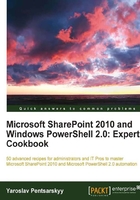
Introduction
PowerShell as a scripting language will execute actions on your target environment. Scripting is not a new concept and PowerShell is definitely not a new language. However, PowerShell and SharePoint 2010 integrate very well. This integration allows administrators and developers to access not just a limited set of commands, but also to connect to SharePoint objects and libraries to take advantage of additional capabilities of SharePoint as a platform. To ensure that we are on the same page while reading this book and trying out various recipes, we'll start by setting up your environment and verifying the setup by running a test script. After all, SharePoint relies on components, most of which we're going to be directly interacting with, and having a consistently configured environment will help in reducing any potential integration issues.
Although we can author our PowerShell scripts in Notepad and execute them in a PowerShell command-line environment, you can experience more advantages from authoring and debugging your scripts by using rich authoring environments, such as PowerGUI or PowerShell ISE. In this chapter, we'll see exactly what the benefits of using those environments are.
Whether you are creating a PowerShell script in a professional scripting environment or calling an existing script from a command line, you'll quickly notice that a default set of commands is definitely not enough to manage and work with your SharePoint system. When you have the need to author scripts accessing various other aspects of SharePoint functionality, you will need to use the additional libraries available to facilitate custom or out-of-the-box functionality required. This is a very common scenario for developers when building custom solutions for a variety of platforms. PowerShell, as a scripting language, really takes advantage of this concept allowing you to call functions from SharePoint and third-party libraries. In this chapter, we'll take a look at exactly how you can access advanced SharePoint 2010 functionality using external libraries.
As you become more familiar with authoring PowerShell scripts, you will realize that you can create a collection of reusable functionality which can be shared with others. That's when you can take advantage of sealing your custom functionality in a portable and sharable way. We'll take a look at how you can package your custom scripts as custom PowerShell CmdLets, as well as how to create a custom PowerShell Snap-In.